A Divine Call from Shiva's Land at somnath mandir
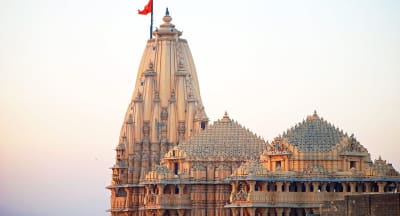
We can find on Earth such corners that do not speak words but sounds of winds, waves and the silence of eternity — Somnath Mandir is one of such divine realms and the temple is placed with divine splendor on the western coast of India where the land meets the sea and time meets timelessness.
Here where Lord Shiva himself is supposed to reside in his Jyotirlinga form, there is a feeling of a certain call by many, the whisper that permeates through the ocean waves, raises the sands and seems to have an outcry to the temple spires; a call by the Divine.
Somnath is a place where a lot of pilgrims come not to observe an ancient era or architecture. They are invited by a God call, an inner voice, a tugging on the heartstrings, so to speak, and often in times of change, change, or a spirit search. However, what will it be that will draw admirers all over the globe? Was it written on the stars?, let's know more about Somnath Mandir —
Somnath: The Moon God’s Redemption
 The meaning of the place name Somnath is “The Lord of the Moon” and its origin is far more in the mythological tale which is cosmically and astrologically worth much. It is believed that Chandra Deva (the Moon God) was cursed by his father-in-law Daksha because he favored one of his 27 wives called Rohini and ignored the rest. The curse made him diminish and become dull.
The meaning of the place name Somnath is “The Lord of the Moon” and its origin is far more in the mythological tale which is cosmically and astrologically worth much. It is believed that Chandra Deva (the Moon God) was cursed by his father-in-law Daksha because he favored one of his 27 wives called Rohini and ignored the rest. The curse made him diminish and become dull.
Chandra in his desperation approached the lord Shiva and did severe penance with the place of Somnath. His devotion overwhelmed Shiva who permitted him to come back into his luminous form, but only in phases, justifying the phases of the Moon.
Not only is it a myth, but it is the basis of lunar astrology, and an incredible lesson that after the dark will come the light, that even when there is a certain setback in terms of our karma, this is no longer the end of the world.
A Temple Reborn Again and Again
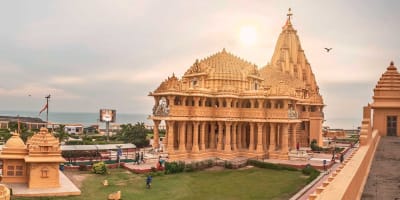 Somnath Mandir has been destroyed and rebuilt several times- at least seventeen times, according to what the legends say. The temple has remained one of the epitomes of the undying spirit of dharma through the invasions of Mahmud of Ghazni and under colonial rule.
Somnath Mandir has been destroyed and rebuilt several times- at least seventeen times, according to what the legends say. The temple has remained one of the epitomes of the undying spirit of dharma through the invasions of Mahmud of Ghazni and under colonial rule.
Every time it was destroyed it was not stone but on every resurrection, it was the human will and the divine grace that appeared. The temple was re-constructed in 1951 in the Chaulukya style of architecture and with its ancient origins sent a loud statement to the world, that truth and devotion cannot be erased due to the vision of Sardar Vallabhbhai Patel.
Why Devotees Feel a ‘Call’ to Somnath
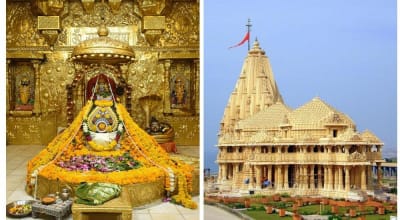 The history of Somnath is more than a history of a temple, it is the epic of faith, returning strength, and cosmos. The moon god, Chandra, it is said, heard this call first. Agonized by a spell that drained his luster, Chandra fled to a territory commonly known as Prabhas Patan located along the Arabian Salty Sea. He went there and meditated about Lord Shiva and kept reciting his name with high devotion. He made his devotee happy and brought out his brilliance and appeared as Somnath, The Lord of the Moon.
The history of Somnath is more than a history of a temple, it is the epic of faith, returning strength, and cosmos. The moon god, Chandra, it is said, heard this call first. Agonized by a spell that drained his luster, Chandra fled to a territory commonly known as Prabhas Patan located along the Arabian Salty Sea. He went there and meditated about Lord Shiva and kept reciting his name with high devotion. He made his devotee happy and brought out his brilliance and appeared as Somnath, The Lord of the Moon.
Astrologically, when the individual is in Chandra Mahadasha, Chandra Antardasha or some difficult Moon transit (such as Ashtama Chandra or Chandra-Rahu conjunction), one can feel overwhelmed emotionally, lost, or spiritually lost.
When we experience times like this, our soul wants to find a place of protection and many of those people who have some relation to lunar forces are to be kept in one place or another.
Somnath as a location of the healing effects of the Moon turns into the cosmic attractor making sensitive souls gravitate toward the healing. This is not a mere chance that most individuals who have been subjected to Moon Moon-dominated birth chart frequently claim that they have dreams, and visions or feel the urge to go to Somnath at a very important stage of their life.
A Meeting Point of Elements
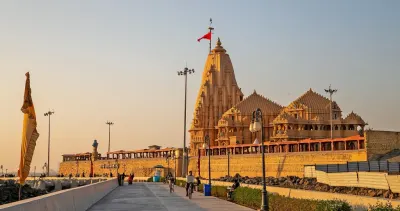 Somnath is indeed magnetic because of its positioning both geographically and cosmically. The location of the temple at the Triveni Sangam is also special as it is where three rivers — Hiran, Kapila and Saraswati turn into the sea. Its waves strike perpetually against the foundations of the temple, a soundtrack, which appears to be a repetition of the name of the God Shiva, synchronized with the rhythmic beating of the heart of the earth.
Somnath is indeed magnetic because of its positioning both geographically and cosmically. The location of the temple at the Triveni Sangam is also special as it is where three rivers — Hiran, Kapila and Saraswati turn into the sea. Its waves strike perpetually against the foundations of the temple, a soundtrack, which appears to be a repetition of the name of the God Shiva, synchronized with the rhythmic beating of the heart of the earth.
When you stand on the edge of the temple, you experience how the five elements awaken the water of the ocean, the wind of the western side, the holy fire through the flames of the aarti, the earth of the legs of the pilgrims and the space around which the birds fly in heavenly patterns. Nature here is turned into a priest itself and performs worship at the altar of the universe.
The Jyotirlinga – Flame of the Infinite
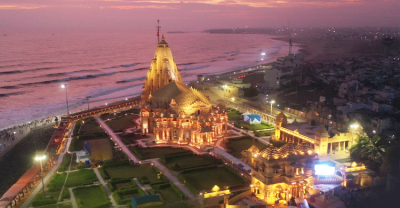 Jyotirlinga of Somnath is regarded as a column of light, that is, a column of pure consciousness, the flame of existence which is immortal. The Lord Shiva symbolizes the unmanifested source and final truth that is beyond the influence of the planets according to astrology.
Jyotirlinga of Somnath is regarded as a column of light, that is, a column of pure consciousness, the flame of existence which is immortal. The Lord Shiva symbolizes the unmanifested source and final truth that is beyond the influence of the planets according to astrology.
Although karmic challenges might be eminent on planets such as Saturn, Mars, or Rahu, Shiva provides the force to overcome the patterns. The pilgrimage to Somnath could be also considered not only an activity but as a representation of one step to leave the untruthful illusion of Maya (worldly attachments) to the never-ending truth.
The pilgrims usually complain that before they visit Somnath, everything appears to be confusing, everything heavy but after the visit to this pilgrim, everything appears to be clear, everything light, and the karmic burden starts to reduce.
Conclusion
Plenty of people tell you that you do not decide to visit Somnath, but rather Somnath decides to visit you. And so, dear reader, when you register this and you sense a trembling in the heart, a desire to be there in the Holy Land, where that sacred shore is, perhaps the Divine is already singing your name.
Somnath is not a name on the map, it is a frequency in your soul, it is a historic memory, waiting to be remembered. You will know there in the silence of its sanctum at the point where the sea sounds and the prayer are one and that those things you have been seeking in the outer world you have found.